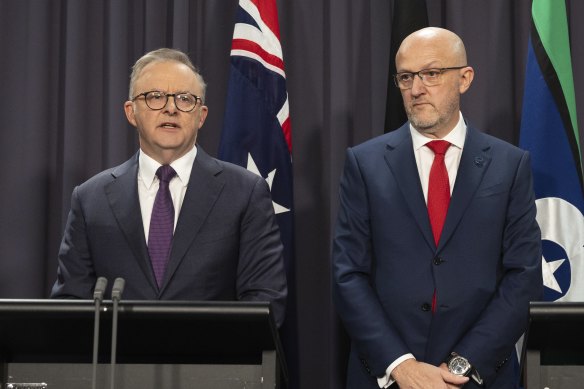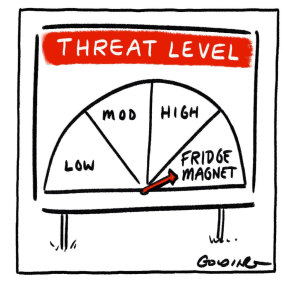This was published 11 months ago
ASIO raises terrorism threat level due to emerging ‘twisted’ ideologies
By Paul Sakkal
Prime Minister Anthony Albanese has begged for calm in the debate over the war in Gaza to stave off politically motivated violence after Australia raised its terrorism threat level for the first time in a decade.
The growing isolation of young men and eight suspected extremist plots since April have put authorities on alert.
Middle East conflict was cited as one of the key factors behind the upgrade of the national threat level from “possible” to “probable”, a decision taken by spy agency ASIO to raise awareness of the increased chance of attacks as riots continue in the United Kingdom weeks after an election and the US and Australia head to the polls within the next year.
Authorities fear a complex mix of fringe ideologies – including anti-government conspiracy theories, racism, Islamist extremism and neo-Nazism – are blending with social media-fuelled personal grievance, intolerance, loneliness and mental ill health.
ASIO boss Mike Burgess said on Monday that instability within society had given rise to “twisted” ideologies that were not as easily defined as the Islamist threat that sparked the previous rise in the terrorism threat level in 2014. He said the segment of Australian society prone to extremism was expanding.
Burgess said the threat level had not been lifted because of a specific imminent threat. The Gaza war was not the reason it had been raised, he said, but was “a significant driver”.
“It’s driven more emotion and heat into society,” he said, elevating politically motivated violence alongside foreign interference and espionage as the nation’s principal security concerns.
“Lawful protests are fine. It’s the people who think violence is the answer.
“Provocative inflammatory behaviours are being normalised. This trend increased during COVID and gained momentum after the terrorist attacks on Israel and accelerated during Israel’s military response. The dynamics are raising the temperature of the security environment.”
Emphasising that “probable does not mean inevitable”, the prime minister implored political opponents to use less heated rhetoric in the fight over the Gaza war.
The Greens have repeatedly accused Labor of being “complicit in genocide” despite the government calling for a ceasefire.
“My message to political leaders is that words matter,” Albanese said.

Prime Minister Anthony Albanese and ASIO chief Mike Burgess on Monday.Credit: Alex Ellinghausen
“Australia, for example, is not directly involved in what is occurring in the Middle East and yet, if you look at the comments that have been made by some senators and [lower house MPs], you would think that that isn’t the case.
“Some of that is designed deliberately to encourage a partisan response in a way that isn’t appropriate. It’s not appropriate for people to encourage some of the actions outside electorate offices and to dismiss them as being just part of the normal political process.”
Albanese’s implicit tying of the Greens’ tactics to the official warning on domestic terrorism raises the stakes in his political fight with the minor party, which is trying to win Labor seats by harnessing anger over Israel’s military actions in the Gaza Strip.
Greens senator David Shoebridge hit back, saying Albanese was ignoring right-wing extremism and using the national security announcement to beat up his enemies.
“Dismissing people’s well-founded concern about Australia’s role in the genocide in Gaza and insinuating that these concerns are somehow associated with a rise in terrorism risk levels will only further divide the community and doesn’t keep us safe,” Shoebridge said in a statement.
Opposition home affairs spokesman James Paterson said it was absurd that new Home Affairs Minister Tony Burke was not at the press conference held by the prime minister on Monday even though his portfolio means he is responsible for domestic security.
Labor has moved ASIO under the umbrella of Attorney-General Mark Dreyfus, who spoke at the press conference.
Paterson said the unwinding of the Coalition’s 2017 move to bring all the domestic national security agencies together in one department proved Labor was “chaotic” on the issue.
Albanese and Burgess urged media companies and activists to turn down the temperature on political rhetoric.
Recent incidents
Intelligence sources said there have been eight suspected extremism incidents in Australia since April, and made mention of three prominent stabbings:
- A bishop was stabbed at a church in the western Sydney suburb of Wakeley in April, during a sermon that was being live-streamed on social media.
- A 16-year-old boy was shot dead by police in May after the teen attacked a man in a car park in the Perth suburb of Willetton.
- A 14-year-old was arrested after allegedly stabbing a 22-year-old student at the University of Sydney in July. The accused allegedly previously planned a terrorist attack.
Albanese’s concerns have been fuelled by eight incidents since April, either carried out or foiled by ASIO, that were believed to be motivated by extremism.
Intelligence sources, who were not authorised to reveal the incidents, said they included the Wakeley church stabbing in western Sydney, in which a bishop was stabbed during a sermon being live-streamed on social media, and recent stabbings in Perth and at the University of Sydney.
Burgess said none of the terrorist plots were believed to have been directly inspired by the Israel-Hamas war, but warned the conflict’s spread to Lebanon could aggravate tensions.
Intelligence sources painted a picture of the type of person who could fall into the trap of online radicalism. They described a financially insecure man living in the suburbs of a big city, struggling to buy a home, judging that too many migrants were living around him, and watching global events with unease, all combining to foster a sense of dislocation that could turn sinister if the person turned to extremist ideology for easy solutions.
The sources said the new security environment was comparable to an El Nino weather system rather than a singular extreme weather event.
Said Burgess: “Now, individuals are being motivated by a diversity of grievances and personal narratives. In some cases I refer to, the alleged perpetrators appeared to be motivated by extreme religious beliefs. In others, nationalist and racist beliefs.
“These factors make ASIO’s job more difficult, [with] the threats becoming harder to predict and identify.”
Albanese added: “There are many things driving this global trend towards violence. Governments around the world are concerned about youth radicalisation, online radicalisation and the rise of new mixed ideologies.”
The raised terrorism threat meant ASIO believed there was a greater than 50:50 chance of an attack. ASIO said that unlike older ideologies that glorified sensational, well-planned attacks, newer movements gave less weight to sensationalism, meaning lone-wolf or small-cell attacks, using cheap weapons, were likely.

Credit: Matt Golding
“Individuals are moving to violence with little or no warning and little or no planning. Acts of violence can be almost spontaneous or purely reactive,” he said, warning that teens were increasingly getting caught up in extremism.
“In the recent cases, the oldest [alleged] perpetrator was 21 and the youngest was 14. Extremist ideologies, conspiracies, misinformation, are flourishing in the online ecosystem and young Australians are particularly vulnerable.”
ASIO last raised the threat level to “probable” in 2014, when significant numbers of radicalised foreign fighters, including Australians, were travelling to Syria and Iraq to join Islamist terrorist groups. It was lowered to “possible” in November 2022 as the risk posed by religiously motivated violent extremists fell.
There are five terrorism threat levels, ranging from “certain” to “not expected”.
Cut through the noise of federal politics with news, views and expert analysis from Jacqueline Maley. Subscribers can sign up to our weekly Inside Politics newsletter here.